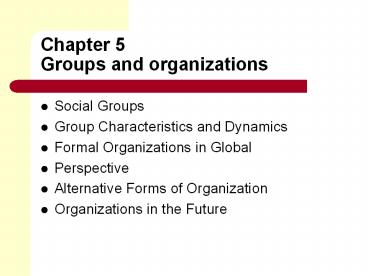Chapter%205%20Groups%20and%20organizations - PowerPoint PPT Presentation
Title:
Chapter%205%20Groups%20and%20organizations
Description:
Chapter 5 Groups and organizations Social Groups Group Characteristics and Dynamics Formal Organizations in Global Perspective Alternative Forms of Organization – PowerPoint PPT presentation
Number of Views:183
Avg rating:3.0/5.0
Title: Chapter%205%20Groups%20and%20organizations
1
Chapter 5Groups and organizations
- Social Groups
- Group Characteristics and Dynamics
- Formal Organizations in Global
- Perspective
- Alternative Forms of Organization
- Organizations in the Future
2
Social Groups
- A collection of two or more people who
- Interact frequently.
- Share a sense of belonging.
- Have a feeling of interdependence.
3
Types of Groups
- Primary and Secondary
- Ingroups and Outgroups
- Reference Groups
4
Cooleys Primary and Secondary Groups
- Primary group - small group whose members engage
in face-to-face, emotion-based interactions. - Secondary group - larger group in which members
engage in impersonal relationships for a limited
period of time.
5
Sumners Ingroups and Outgroups
- Groups set boundaries between insiders and
outsiders. - Distinguishing between ingroups and outgroups
helps us establish our identity. - May encourage group cohesiveness, but may also
promote classism, racism, sexism and ageism.
6
Group Size
- Size is one of the most important features of a
group. - As size increases, communication patterns between
group members change. - Larger groups typically have more formalized
leadership structures.
7
Group Leadership Styles
- Authoritarian leaders - often criticized for
fostering intergroup hostility. - Democratic leaders - praised for supportive
behavior and blamed for being indecisive in a
crisis. - Laissez-faire leaders - do not provide active
leadership.
8
Research on Group Conformity
- Asch - demonstrated that people will bow to
social pressure in small group settings. - Milgram - obedience to authority may be more
common than most of us would like to believe. - Pryor and McKinney - suggest a relationship
between group conformity and harassment.
9
Groupthink
- Members of groups limit their opinions to focus
on consensus. - Members of a group arrive at a decision that
individual members believe is unwise. - 1986 challenger tragedy has been cited as an
example of this process.
10
Etzionis Classification of Formal Organizations
- Normative organizations are joined voluntarily.
(political parties, religious organizations and
social clubs) - Coercive organizations are associations people
are forced to join. (prisons) - Utilitarian organizations provide rewards.
(colleges and universities, the workplace)
11
Webers Ideal Characteristics of Bureaucracy
- Division of Labor
- Hierarchy of Authority
- Rules and Regulations
- Qualification-Based Employment
- Impersonality
12
Shortcomings of Bureaucracy
- Inefficiency and Rigidity
- Resistance to Change
- Perpetuation of Race, Class, and Gender
Inequalities
13
Alternative Forms of Organization
- Humanizing the bureaucracy
- Greater sharing of power and responsibility.
- Encouragement of participants to share their
ideas and try new approaches. - Efforts to reduce the number of people in
dead-end jobs and to help people meet family
responsibilities.
14
Organizational Structure in Japan
- Lifetime employment - workers were (until
recently), guaranteed permanent employment after
an initial probationary period. - Quality circlessmall workgroups that meet
regularly with managers to discuss the groups
performance and working conditions.































